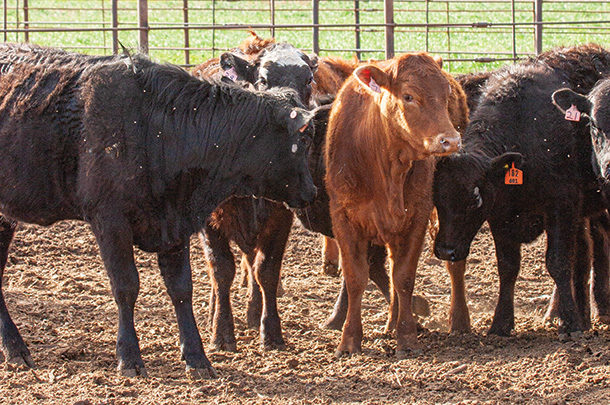All beef producers understand the importance of feed efficiency; it’s the ratio of the pounds of feed required to achieve a pound of gain. And producers understand that if feed efficiency is measured based on dry matter intake (DMI), feeding a more energy-dense diet will improve feed efficiency. This is the reason cattle are stepped up onto a finishing ration as quickly as possible.
However, transition to the finishing ration is a balancing act between maximizing efficiency and minimizing the effects of acidosis. The negative effects of acidosis are largely due to organic acid accumulation in the rumen, especially lactic acid. Lactic acid has the most potential to cause issues because it’s 10 times more acidic than other ruminal acids.
Shorten the step-up period
One tool available to cattle producers to help shorten the finishing diet step-up period is a ruminal bacteria called Megasphaera elsdenii. M. elsdenii is a lactic acid-metabolizing bacteria that naturally increases in the rumen as cattle are fed increasing levels of concentrate.
However, native megasphaera grows much slower than lactic acid producers in the rumen, so adaptation to high-grain diets takes time. Use of supplemental M. elsdenii can shorten the finishing diet adaptation period by 50% or more. Another benefit of M. elsdenii is butyrate production. This volatile fatty acid stimulates growth of rumen papillae. These papillae are crucial for absorption of nutrients produced during rumen fermentation and help regulate rumen pH through absorption of organic acids.
A shorter step-up improves operational efficiency
Several commercial research trials have shown that cattle given the appropriate amount of M. elsdenii can be stepped up on finishing ration in half the normal amount of time, or less. This allows an operation to feed less total feed, most of which is roughage, to achieve the same growth performance, thus improving operational efficiency.
Detailed ration intake data exists for two commercial feedyard trials conducted in Kansas and Colorado where M. elsdenii was used. In the Kansas trial, a 24-day step-up was compared to a 13-day step-up with supplemental megasphaera. In the Colorado trial, a 19-day step-up was compared to a 10-day step-up or a two-day step-up with supplemental megasphaera.
When compared to control cattle, total DMI was reduced in all three treatments. Average daily gains (ADGs) were not negatively impacted by the reduction in intake because cattle were consuming a more energy-dense diet, but feed efficiency was improved 2.4% to 3.3%. No negative impacts on health were seen from accelerated adaption programs that included M. elsdenii. However, cattle in the Kansas trial that were stepped up in 13 days without M. elsdenii experienced greater death loss compared to controls.
If we average ration and ingredient intake reductions across the three trial treatments, an operation would replace 122 tons of step-up ration with 86 tons of finishing ration for every 1,000 head of cattle fed in an accelerated step-up program. This means an operation would feed 36 fewer tons of total feed, 33 tons of which is roughage.
The efficiency of feeding fewer total tons of feed to achieve the same gain is obvious, but it is also important to recognize that step-up rations are bulkier than finishing rations because they contain greater amounts of roughage and thus require more truck loads to deliver the same number of calories to cattle.
Feeding less roughage further increases operational efficiency because roughage must be processed, and shrink can be high compared to other ingredients. There are also potential cost savings when feeding less roughage due to limited supply in some areas of the U.S. Depending on yard size and uniformity of the cattle being fed, some yards can use accelerated step-up programs to reduce the number of rations manufactured by the yard. This approach provides the greatest operational efficiency benefit because it further reduces the number of partial loads of feed.
Reduce manure output
Research at Kansas State University demonstrated that feeding a finishing diet on day one after M. elsdenii administration reduced manure production because roughage is less digestible than other feedstuffs. Taking their estimates for dry matter manure output reduction, for every 1,000 head fed in that accelerated program, an operation would scrape, haul and spread 24 fewer tons of manure, assuming 67% dry matter content of manure removed from the pen at the end of the finishing period.
Reducing the amount of time it takes to get cattle onto the most efficient ration improves not only the feed efficiency of cattle but also improves efficiency of the operation. With the ability to feed more energy-dense diets when M. elsdenii is utilized, the same gain or even more can be achieved with fewer pounds of feed and fewer loads of feed. Additionally, feeding a more digestible diet will reduce manure output. All of this means savings on feeding equipment purchases and maintenance, roughage purchases and subsequent shrink, and the labor needed to process, load, mix and deliver feed.
Please note that it is generally recommended to reduce step-up programs by no more than 50% when initiating an accelerated step-up strategy in an operation. It is also imperative that any change made to a step-up program is done under the guidance of a qualified nutritionist and that proper bunk management is employed. Please contact me if you have questions.









